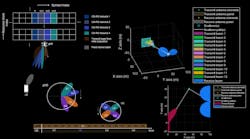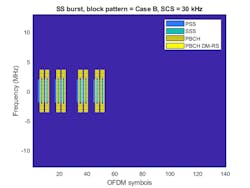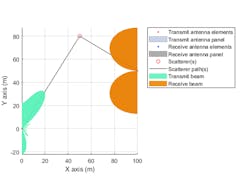Algorithms to Antenna: 5G NR Beam Sweeping and Beam Refinement
We previously wrote about modeling 5G systems in a blog that described waveform generation. Here, our focus shifts to beam sweeping and beam refinement. We explain how beam sweeping can be utilized at both the base-station (gNB) and user-equipment (UE) ends of a 5G NR downlink system. We start with synchronization signal blocks (SSBs) employed during initial accesses as a UE enters a new area of coverage. Later on, we show how beams can be further refined to improve the data transfer in an existing connection.
Beam Sweeping to Establish a Connection
Since the systems operate at millimeter-wave (mmWave) frequencies, directional links between the transmitter and UE require beam-management procedures to establish the initial access. Beam management spans Layer 1 (physical) and Layer 2 (medium access control) procedures and is used to acquire and maintain a set of beam-pair links. Our focus is on beamsteering to start, but the related procedures include:
- Beam sweeping
- Beam measurement
- Beam determination
- Beam reporting
- Beam recovery
SSBs are transmitted as a burst in the downlink direction to the UE. Transmit/receive point (TRP) beam sweeping and UE beam sweeping are used to establish the beam-pair link based on procedures defined in TR 38.802 (procedure P-1). Once the connection is established, this same beam-pair link can be applied to subsequent transmissions.
In our example, we generate a synchronization signal burst and beamform each of the SSBs within the burst to sweep both azimuth and elevation directions. The system transmits this beamformed signal over a spatial scattering channel, and the received signal is processed over multiple receive-end beams.
The reference signal received power (RSRP) is measured for each of the transmit-receive beam pairs, and the beam-pair link with the maximum RSRP is used. Figure 1 illustrates the main processing steps with the beam-management steps highlighted.
To set up the scenario, we define a uniform rectangular array (URA) with isotropic antenna elements to sweep beams in the azimuthal sweep and elevation directions with an SS burst periodicity of 20 ms. The resulting SS burst waveform is shown in Figure 2.
To achieve TRP beam sweeping, we beamform each SSB within the generated burst using analog beamforming. Based on the number of SSBs in the burst and the sweep ranges, we determine the azimuth and elevation directions for each beam. Individual blocks within the burst are each sent in the direction of the beams over the spatially aware scattering channel.
For receive-end beam sweeping, the transmitted beamformed burst waveform is received successively over each receive beam. From procedure P-1, each of the N beams is transmitted M times so that each transmit beam is received over the M receive beams. For simplicity, we assume M = N = 4.
Figure 3 shows a beam-based diagram for the sweeps in the azimuthal plane at both the transmitter and the UE for N = M = 4. The diagram reveals the time taken for the dual sweep, where each interval at gNB corresponds to an SSB and each interval at the UE corresponds to the SS burst. For this scenario, beams S3 and U2 are highlighted as the selected beam-pair link.
In our model, the receive processing of the transmitted burst includes:
- Fading channel and additive white Gaussian noise (AWGN)
- Receive-end beamforming
- Timing correction
- Orthogonal frequency-division multiplexing (OFDM) demodulation
- Extraction of the known SSB grid
- Measurement of the RSRP
This process repeats for each of the receive beams, and we select the best beam-pair based on the complete set of measurements.
After the dual-end sweep completes and measurements are made, the best beam-pair link based on the RSRP measurement is:
- Selected Beam pair with RSRP: 45.1564 dBm
- Transmit #8 (Azimuth: 60, Elevation: 0)
- Receive #6 (Azimuth: 90, Elevation: 0)
Figure 4 illustrates the transmit beam pattern generated from the array (left) and the receive beam pattern (right).
Figure 5 shows the transmit and receive directivity patterns in addition to the spatial scene. The results depend on the individual beam directions used for the sweeps. The spatial scene includes a combined view of the transmit and receive arrays, along with the determined beams and scatterers.
Using the examples and features in 5G Toolbox, you can try varying frequency ranges, SSB block patterns, the number of SSBs, the transmit and receive array sizes, transmit and receive sweep ranges, and the measuring mode.
NR Downlink Transmit-End Beam Refinement
Once the initial beam-pair links are established, we can perform beam refinement to further improve the connection. To do this, we add a downlink transmit-end beam-refinement procedure using the channel state information reference signal (CSI-RS) from 5G Toolbox.
First, we transmit multiple CSI-RS resources in different directions in the scattering environment. The optimal transmit beam is again selected based on the RSRP measurements. This type of refinement procedure is needed because at mmWave frequencies the transmitted signal is susceptible to high path loss and penetration loss, which affects the link budget.
As we noted with beam scanning, beam management is also part of the Layer 1 (physical layer) and Layer 2 (medium access control) procedures to establish and retain an optimal beam pair for a quality connection. TR 38.802 Section 6.1.6.1 defines beam management as three procedures. We already discussed P-1 in the first part of this blog.
Procedure P-2 focuses on transmit-end beam refinement, where the beam sweeping happens at the transmit end by keeping the receive beam fixed. The procedure is based on non-zero-power CSI-RS (NZP-CSI-RS) for downlink transmit-end beam refinement and sounding reference signal (SRS) for uplink transmit-end beam refinement.
Procedure P-3 focuses on receive-end beam adjustment, where the beam sweeping happens at the receive end given the current transmit beam. The goal is to find the best receive beam, which can be a neighboring beam or a refined beam.
For P-3, a set of reference signal resources (NZP-CSI-RS for downlink and SRS for uplink) are transmitted with the same transmit beam, and the UE or gNB receives the signal using different beams from different directions covering an angular range. Subsequently, the best receive beam is selected based on the RSRP measurements on all receive beams.
We focus on the downlink beam refinement at the transmitter. Figure 6 shows the transmit-end beam-refinement procedure, considering four NZP-CSI-RS resources transmitted in four different directions. These four directions are "within" the initial beam identified by SSB sweeps.
With this in place, we configure the azimuth and elevation beamwidths of the SSB transmit beam from the initial acquisition process (P-1). The SSB transmit beam direction is aligned (partially or fully) to the position of the scatterer using the beamwidths in both the azimuth and elevation planes. The beam directions (azimuth and elevation angle pairs) are calculated for all active CSI-RS resources within the angular range covered by the SSB transmit beam.
The system loops over all NZP-CSI-RS resources and applies digital beamforming to all active resources. Digital beamforming is used because it provides frequency selective beamforming within the same OFDM symbol. From this point, we generate the time-domain waveform by performing the OFDM modulation, including timing synchronization, by cross-correlating the received reference symbols with a local copy of NZP-CSI-RS symbols.
To perform digital beamforming at the receiver side, steering weights are applied for this single UE scenario. The expanded processing chain is shown in Figure 7.
Figure 8 depicts the scattering MIMO scenario (including transmit and receive antenna arrays, scatterer positions and their paths, and all the transmit and receive antenna array beam patterns).
After the OFDM demodulation, the UE measures the RSRP for all of the CSI-RS resources transmitted in different beams, given the current receive beam.
RSRP measurements of all CSI-RS resources (in dBm):
| 40.1313 | 31.0269 | 27.0399 | 42.9433 | 34.8756 | 29.2513 |
| 37.7758 | 31.3422 | 22.2327 | 15.931 | 11.258 -1.92416 |
The maximum RSRP value from the measurements helps us find the best corresponding beam, which in this case is:
- From initial beam acquisition:
- Beamwidth of initial SSB beam in azimuth plane is: 30 degrees
- Beamwidth of initial SSB beam in elevation plane is: 30 degrees
- With transmit-end beam refinement:
- Refined transmit beam (4) corresponds to CSI-RS resource 4 is selected in the direction [10;15]
- Beamwidth of refined transmit beam in azimuth plane is: 12.98 degrees
- Beamwidth of refined transmit beam in elevation plane is: 13.25 degrees
Applying this procedure identifies a transmit beam that’s finer than the beam from the initial acquisition.
As was the case from the first part of the blog, you can configure multiple CSI-RS resources, transmit and receive antenna-array configurations, and multiple scatterers to see the variations in the selection of the refined beam.
To learn more about the topics covered in this blog, see the examples below or email me at [email protected]:
- NR SSB Beam Sweeping (Example): Learn how to employ beam sweeping at both the transmitter (gNB) and receiver (UE) ends of a 5G NR system.
- NR Downlink Transmit-End Beam Refinement Using CSI-RS (Example): Learn how to how to transmit multiple CSI-RS resources in different directions in a scattering environment and how to select the optimal transmit beam based on reference signal received power (RSRP) measurements.
- MIMO Communications Applications (Documentation): Learn how to model multiple-input, multiple-output communications systems using phased-array antennas and spatial-signal-processing algorithms.
See additional 5G, radar, and EW resources, including those referenced in previous blog posts.








